Create multiple, switchable desktops in Windows
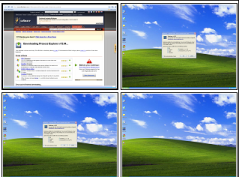 Are you the kind of person who keeps a lot of applications running simultaneously in Windows? Sometimes it gets so clogged up that it starts to take up time carrying out tasks. You can solve this problem with a second screen in many ways, but if you cannot do that, then there is another solution. The "Desktops" application from Sysinternals (acquired by Microsoft) allows you to create up to four virtual Dekstops that you can switch between with your keyboard or mouse. This can save a lot of time and is a very convenient way to handle multiple applications at once.
Are you the kind of person who keeps a lot of applications running simultaneously in Windows? Sometimes it gets so clogged up that it starts to take up time carrying out tasks. You can solve this problem with a second screen in many ways, but if you cannot do that, then there is another solution. The "Desktops" application from Sysinternals (acquired by Microsoft) allows you to create up to four virtual Dekstops that you can switch between with your keyboard or mouse. This can save a lot of time and is a very convenient way to handle multiple applications at once.Introduction & Requirements
| Software you must download and install | |
| Desktops | |
| Required: You need to download Desktops from AfterDawn. It is in a ZIP file so you will have to extract the executable from it. Download |
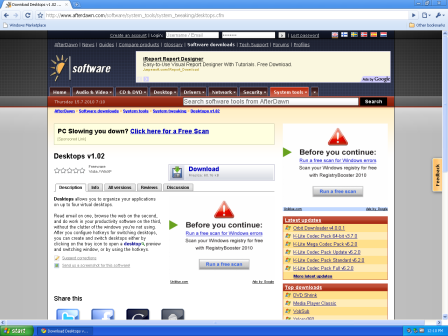
Download the Desktops ZIP file and copy the executable file into a normal directory. There is no installation for Desktops, you simply run it once you have it in a normal file folder.
Sysinternals License Agreement
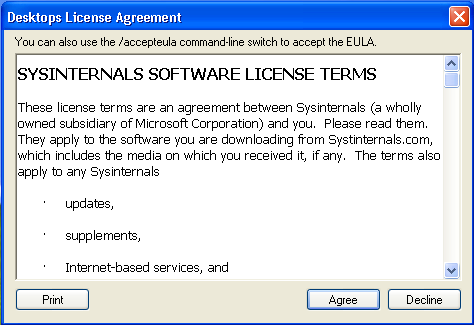
When you run Desktops (and most Sysinternal GUI applications) for the first time, you will have to accept the End User License Agreement (EULA). When you click the Agree button, the software will write a new DWORD value (EulaAccepted with a value of 1) to the Windows registry key HKCU/Software/Sysinternals/Desktops/. Unless this is manually deleted, Desktops should now ask you to accept the EULA again when you launch it. Other Sysinternals software will still prompt the user to accept the EULA at first use however.
Click Agree when you are ready and the Desktops interface should display immediately in a small window.
Desktops settings
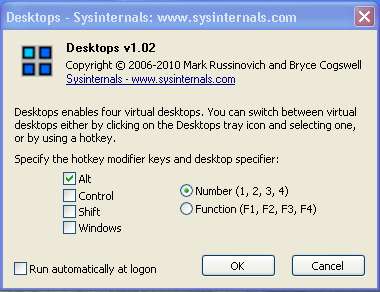
When running, Desktops allows you to use four virtual Desktops (well, technically three Desktops and your original Windows desktop) and allows you to switch between them either using the mouse or by using pre-defined hotkey combinations (you can change these later). As you can see from the user interface, you have four choices for hotkeys (ALT, CTRL, SHIFT or WINDOWS key) and you and you can use more than one. Then, you can use either the numbers 1, 2, 3 or 4, or you can use the keys F1, F2, F3 or F4 to specify which Desktop out of the 4 to switch to.
So, as an example. Let's say I am on Desktop 1 (original Windows Desktop), and I wanted to switch to Desktop 2 (note that if you haven't already created Desktop 2, then Desktops will create it for you). I have decided to use the ALT key as my sole hotkey, and I have decided to use 1, 2, 3 and 4 to differentiate between Destkops (as shown in the picture above), to get to Desktop 2 (or create it) I simply hold down ALT + 2. Now if I had specified CTRL as my sole hotkey, and F1, F2, F3 and F4 to differentiate between Desktops, then I would hold down CTRL + F2 to get to Desktop 2.
If I decided I wanted to use both ALT and CTRL as my hotkeys, and F1, F2, F3 and F4 to differentiate between Destkops, then I would need to hold down CTRL + ALT + F2 to get to Desktop 2. This is pretty simple stuff to understand but if it is not clear now it will become clear as you practice.
When you have chosen the right combination of keys to use to switch between Desktops, press the OK button and a new icon will appear in the system tray (lower right corner of the screen by the clock).
Creating / Switching Desktops with Mouse

When the Desktops application is running, you can find an icon in the system tray on the Windows taskbar (lower right corner). If you click on this icon, it will show you small thumbnail pictures of each running Desktop. By simply clicking the icon, you can switch to any of the four Desktops or if they haven't been created yet, you can create them with a single click.
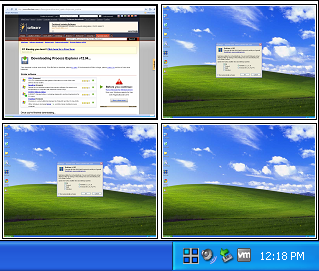
Give it a try. On each newly loaded Desktop you will see all of the icons on your Desktop that you generally see with your user account. However, your taskbar should be completely empty. You can run any application you want as you usually would on your primary Desktop. If you switch back to another Desktop, your application will stay running. You will only get a completely fresh Desktop when you create a new one.
What does Desktops do in the background?
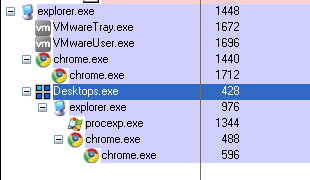
Above is a cropped screenshot of Process Explorer running on a Windows system that is running Desktops. The Process Tree display shows us that the Desktops.exe process ran a new Explorer.exe process (and does so for every Desktop you create). You can then also see in Process Explorer that I have ran procexp.exe (Process Explorer) and Google Chrome on a virtual Desktop. Besides rebooting, Process Explorer is the only way I've found to kill the Desktops application without a reboot. Even if you have done that, you will still need to kill any explorer.exe process or other processes you have ran inside the virtual desktops. A reboot seems like a better option.
Running Desktops at Start-up

In Desktops settings (which you can get to by right-clicking the Desktops icon and clicking Options), there is also an option to Run automatically at Logon. Selecting this options, and clicking OK, will add a STRING value (Sysinternals Desktops, value is file location) to the Windows registry key HKCU\Software\Microsoft\Windows\CurrentVersion\Run as you can see in the cropped screenshot of Autoruns above. Running it automatically at start-up does not mean it will create three extra Desktops automatically, you still need to manually do that. However it will remember the hotkey settings that you made.
Finally
Desktops is a wonderful application and it can really help to speed things up. It is particularly handy in many ways, such as keeping an image editor open on one virtual desktop while keeping a browser on another. Instead of manually switching between applications you can just use the hotkey to jump to a different Desktop and on most machines this jump is instant. If you have any problems or need assistance, please visit our Discussion Forums.

